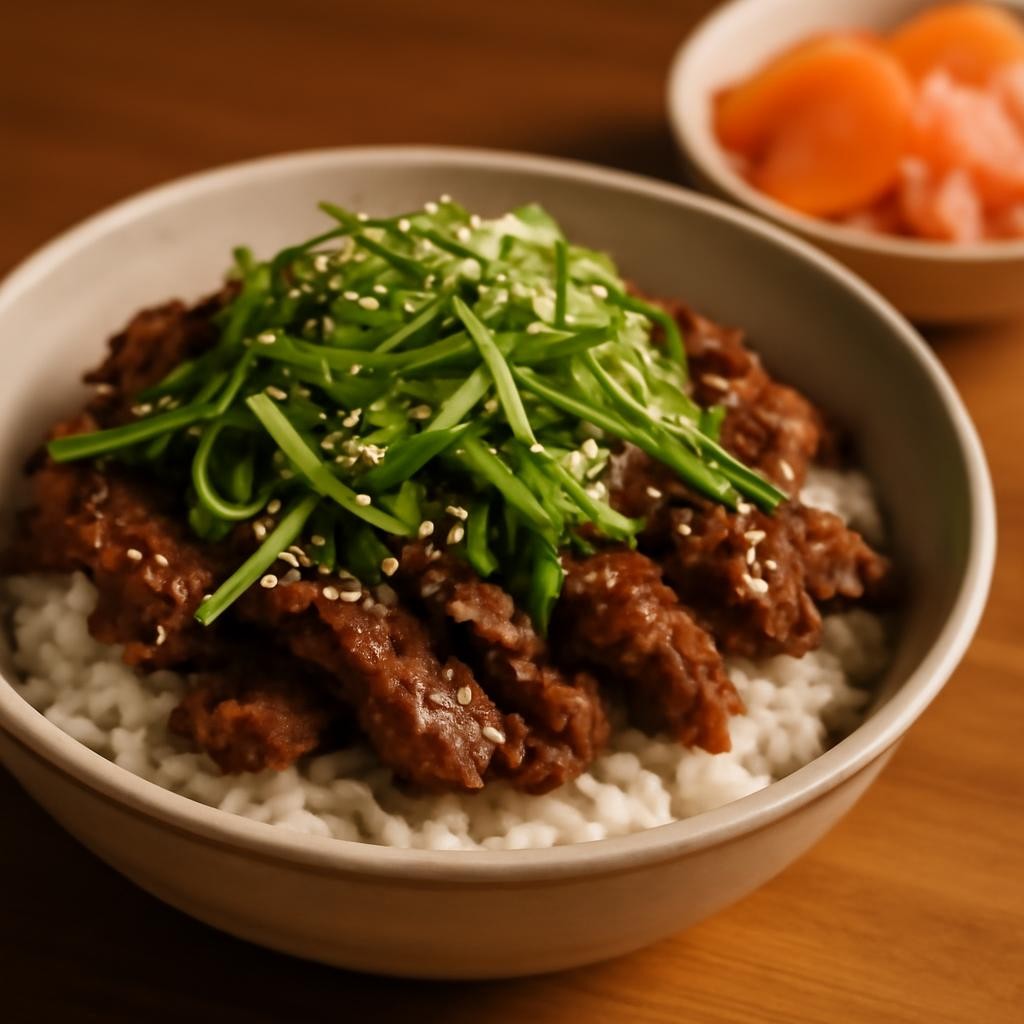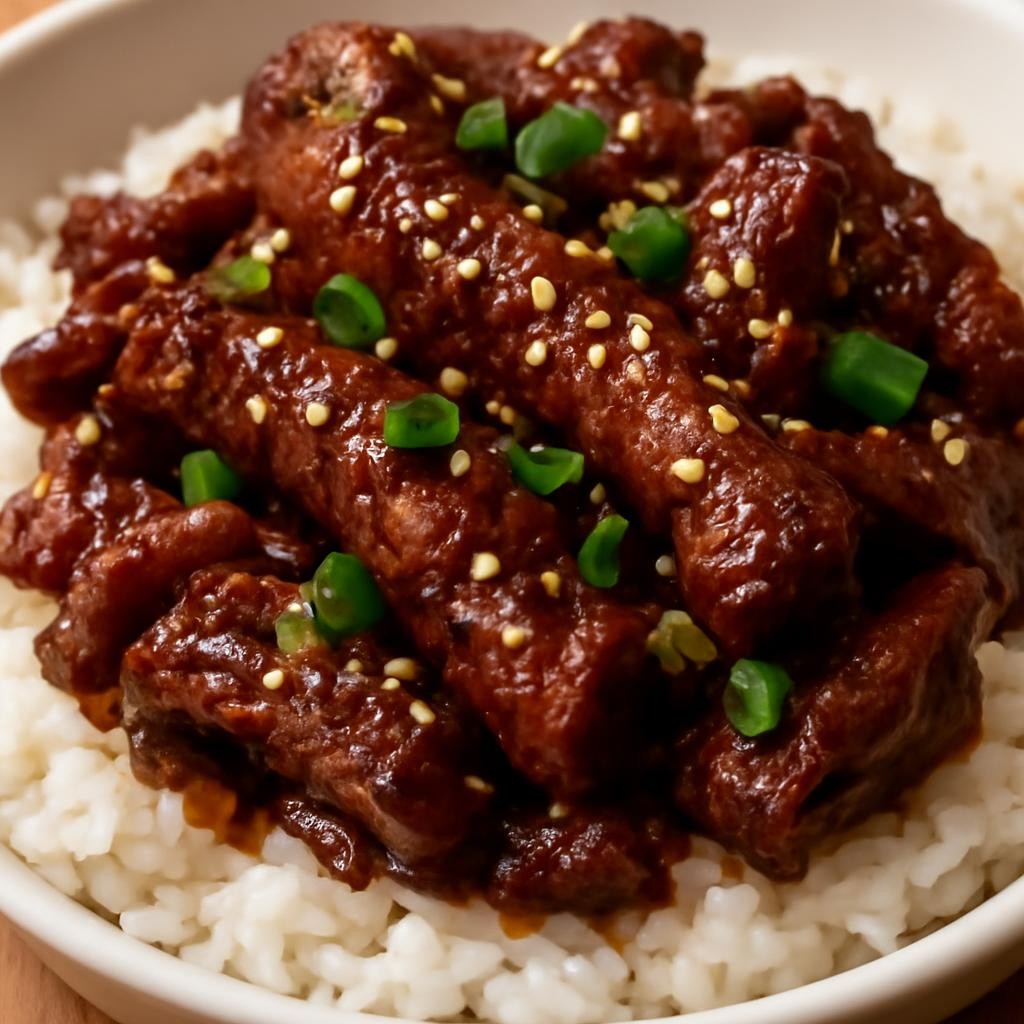This Korean beef recipe brings the vibrant flavors of Korean cuisine right to your kitchen. Featuring tender strips of beef marinated in a delightful blend of soy sauce, sesame oil, garlic, and ginger, this dish is not only easy to prepare but also incredibly satisfying. The combination of sweet, savory, and slightly spicy notes will tantalize your taste buds, making it a perfect weeknight dinner or a show-stopping dish for your next gathering.

Why You Will Love This Recipe
Readers will adore this Korean beef recipe for several reasons. Firstly, the flavor profile is irresistible; the marinade infuses the beef with a depth of flavor that is both comforting and exciting. Secondly, the cooking process is straightforward, making it accessible even for novice cooks. The dish can be ready in under 30 minutes, perfect for busy weeknights. Lastly, it’s a protein-packed meal that fits well within various dietary lifestyles, including low-carb and high-protein diets, allowing you to enjoy a delicious and nourishing dinner without much fuss.
Tips and Tricks
1. Marination Time: For the best flavor, marinate the beef for at least 30 minutes, but if you have time, let it sit for a few hours or overnight.
2. Cutting the Beef: Slice the beef against the grain for maximum tenderness. A sharp knife will help achieve thin, even slices.
3. High Heat Cooking: Use a high heat setting when cooking to achieve a nice sear on the beef, which locks in the juices and flavor.
4. Garnish Wisely: Fresh herbs like green onions or sesame seeds can elevate the presentation and add a pop of flavor without much effort.
Make Ahead Tips
You can marinate the beef up to 24 hours in advance, allowing the flavors to develop even further. Additionally, you can slice the vegetables and prepare the marinade a day ahead, storing them separately in the fridge to save time on cooking day. Cooked beef can be stored in the refrigerator for up to three days.

Recipe Variations
Consider trying different cuts of beef, such as flank steak or sirloin, for varied texture and flavor. You can also add vegetables like bell peppers, carrots, or snap peas to the stir-fry for added nutrition and color. For a spicier version, add sliced chili peppers or a dash of gochujang (Korean chili paste) to the marinade.
How to Serve
Serve the Korean beef over a bed of fluffy steamed rice or quinoa to soak up the flavorful juices. Garnish with sesame seeds and finely sliced green onions for a beautiful presentation. For a complete meal, consider serving alongside a simple cucumber salad or kimchi to balance the flavors.

Pairing Suggestions
For drink pairings, a chilled glass of soju or a light lager beer works beautifully, complementing the rich flavors of the beef. If you prefer non-alcoholic options, iced green tea or a refreshing lemonade will pair nicely. Complement your meal with a side of stir-fried vegetables or a sweet Asian-style dessert like mochi or fruit salad.
How to Store
Store any leftover Korean beef in an airtight container in the refrigerator for up to three days. For longer storage, you can freeze the beef for up to three months. When reheating, do so gently on the stovetop or in the microwave to avoid overcooking.
Equipment Needed
You will need a sharp knife for slicing the beef, a cutting board, a mixing bowl for the marinade, and a skillet or wok for cooking. If you don’t have a wok, a large frying pan will suffice.

Dietary Adaptations
To make this recipe vegan, substitute the beef with tofu or tempeh and use a plant-based soy sauce. For a gluten-free version, opt for tamari instead of regular soy sauce. Ensure that all other ingredients are gluten-free as well.
Seasonal Adaptations
In the spring and summer, consider using fresh vegetables like zucchini and bell peppers in the stir-fry. In the fall and winter, hearty vegetables like carrots and broccoli can lend a comforting touch to the dish.
Recipe FAQs
1. Can I use chicken instead of beef? Yes, chicken thighs or breasts can be used with the same marinade for a delicious result.
2. What can I substitute for soy sauce? Coconut aminos is a great soy sauce alternative for a soy-free option.
3. How long should I cook the beef? Typically, 3-4 minutes on high heat is sufficient, but it may vary depending on the thickness of the slices.
How To Make korean beef recipe
Korean Beef

This Korean beef recipe brings the vibrant flavors of Korean cuisine right to your kitchen.
Ingredients
- 1 lb beef (flank steak or sirloin)
- 1/4 cup soy sauce
- 2 tbsp sesame oil
- 2 tbsp brown sugar or honey
- 3 cloves garlic, minced
- 1 inch ginger, grated
- 1/2 tsp black pepper
- 1 tbsp vegetable oil (for cooking)
- 2 green onions, chopped (for garnish)
- Sesame seeds (for garnish)
Instructions
- Prepare the Marinade: In a mixing bowl, combine soy sauce, sesame oil, brown sugar, minced garlic, grated ginger, and black pepper. Whisk until well combined.
- Marinate the Beef: Slice the beef against the grain into thin strips. Add to the marinade, ensuring all pieces are coated. Cover and refrigerate for at least 30 minutes or up to 24 hours.
- Heat the Pan: In a large skillet or wok, heat vegetable oil over high heat until shimmering.
- Cook the Beef: Add the marinated beef to the hot pan in a single layer. Cook for about 3-4 minutes, stirring occasionally, until browned and cooked through.
- Garnish and Serve: Remove from heat. Garnish with chopped green onions and sesame seeds before serving.
Nutrition Information:
Yield: 4 Serving Size: 1Amount Per Serving: Calories: 476Total Fat: 33gSaturated Fat: 10gTrans Fat: 1gUnsaturated Fat: 20gCholesterol: 99mgSodium: 936mgCarbohydrates: 14gFiber: 1gSugar: 10gProtein: 32g
Asianplated.com, occasionally offers nutritional information for recipes contained on this site. This information is provided as a courtesy and is an estimate only. This information comes from online calculators. Although allchickenrecipes.com attempts to provide accurate nutritional information, these figures are only estimates.
Final Thoughts
This Korean beef recipe is a fantastic way to bring bold flavors and satisfying textures to your dinner table with minimal effort. Whether you’re cooking for your family or entertaining guests, this dish is sure to impress. Enjoy the process of cooking, and don’t hesitate to experiment with your own twists to make it uniquely yours! Happy cooking!


















